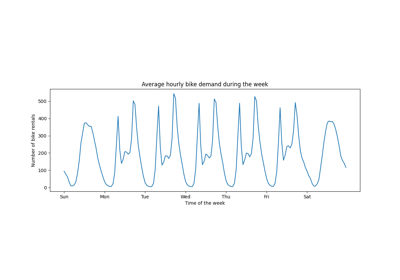neuraxle.union¶
Module-level documentation for neuraxle.union. Here is an inheritance diagram, including dependencies to other base modules of Neuraxle:
Union of Features¶
This module contains steps to perform various feature unions and model stacking, using parallelism is possible.
Classes
|
Parallelize the union of many pipeline steps AND concatenate the new features to the received inputs using Identity. |
|
Parallelize the union of many pipeline steps. |
|
Performs a |
|
This class receives an iterable of DataContainer and zips their feature together. |
Examples using neuraxle.union.AddFeatures¶
Examples using neuraxle.union.FeatureUnion¶
Examples using neuraxle.union.ModelStacking¶
-
class
neuraxle.union.FeatureUnion(steps_as_tuple: List[Union[Tuple[str, BaseTransformerT], BaseTransformerT]], joiner: neuraxle.base.BaseTransformer = None, n_jobs: int = None, backend: str = 'threading', cache_folder_when_no_handle: str = None)[source]¶ Bases:
neuraxle.base.ForceHandleOnlyMixin,neuraxle.base.TruncableStepsParallelize the union of many pipeline steps.
p = Pipeline([ FeatureUnion([ Mean(), Std(), ], joiner=NumpyConcatenateInnerFeatures()) ]) data_inputs = np.random.randint((1, 20))
See also
ModelStacking,AddFeatures,ForceHandleOnlyMixin,TruncableSteps,BaseStep-
__init__(steps_as_tuple: List[Union[Tuple[str, BaseTransformerT], BaseTransformerT]], joiner: neuraxle.base.BaseTransformer = None, n_jobs: int = None, backend: str = 'threading', cache_folder_when_no_handle: str = None)[source]¶ Create a feature union. :type cache_folder_when_no_handle:
str:type backend:str:type n_jobs:int:type joiner:BaseTransformer:param steps_as_tuple: the NamedStepsList of steps to process in parallel and to join. :param joiner: What will be used to join the features.NumpyConcatenateInnerFeatures()is used by default. :param n_jobs: The number of jobs for the parallelizedjoblib.Parallelloop in fit and in transform. :param backend: The type of parallelization to do withjoblib.Parallel. Possible values: “loky”, “multiprocessing”, “threading”, “dask” if you use dask, and more.
-
_fit_data_container(data_container, context)[source]¶ Fit the parallel steps on the data. It will make use of some parallel processing. :param data_container: The input data to fit onto :param context: execution context :return: self
-
_transform_data_container(data_container, context)[source]¶ Transform the data with the unions. It will make use of some parallel processing. :param data_container: data container :param context: execution context :return: the transformed data_inputs.
-
_did_transform(data_container, context)[source]¶ Apply side effects after transform.
- Parameters
data_container – data container
context – execution context
- Returns
data container
-
_fit_transform_data_container(data_container, context)[source]¶ Transform the data with the unions. It will make use of some parallel processing. :param data_container: data container :param context: execution context :return: the transformed data_inputs.
-
_did_fit_transform(data_container, context)[source]¶ Apply side effects after fit transform.
- Parameters
data_container – data container
context – execution context
- Returns
(fitted self, data container)
-
_abc_impl= <_abc_data object>¶
-
-
class
neuraxle.union.ZipFeatures(concatenate_inner_features=False)[source]¶ Bases:
neuraxle.base.NonFittableMixin,neuraxle.base.BaseStepThis class receives an iterable of DataContainer and zips their feature together. If concatenate_inner_features is True, then features are concatenated after being zipped.
-
__init__(concatenate_inner_features=False)[source]¶ Initialize self. See help(type(self)) for accurate signature.
-
transform(data_inputs)[source]¶ Transform given data inputs.
- Parameters
data_inputs – data inputs
- Returns
transformed data inputs
-
_transform_data_container(data_container: neuraxle.data_container.DataContainer, context: neuraxle.base.ExecutionContext) → neuraxle.data_container.DataContainer[source]¶ Transform data container.
- Return type
- Parameters
data_container (
DataContainer) – data containercontext (
ExecutionContext) – execution context
- Returns
data container
-
_abc_impl= <_abc_data object>¶
-
-
class
neuraxle.union.AddFeatures(steps_as_tuple: List[Union[Tuple[str, BaseTransformerT], BaseTransformerT]], **kwargs)[source]¶ Bases:
neuraxle.union.FeatureUnionParallelize the union of many pipeline steps AND concatenate the new features to the received inputs using Identity.
pipeline = Pipeline([ AddFeatures([ PCA(n_components=2), FastICA(n_components=2), ]) ])
See also
FeatureUnion,ModelStacking,ForceHandleOnlyMixin,TruncableSteps,BaseStep-
__init__(steps_as_tuple: List[Union[Tuple[str, BaseTransformerT], BaseTransformerT]], **kwargs)[source]¶ Create a
FeatureUnionwhereIdentityis the first step so as to also keep the inputs to concatenate them to the outputs. :param steps_as_tuple: The steps to be sent to theFeatureUnion.Identity()is prepended. :param kwargs: Other arguments to send toFeatureUnion.
-
_abc_impl= <_abc_data object>¶
-
-
class
neuraxle.union.ModelStacking(steps_as_tuple: List[Union[Tuple[str, BaseTransformerT], BaseTransformerT]], judge: neuraxle.base.BaseStep, **kwargs)[source]¶ Bases:
neuraxle.union.FeatureUnionPerforms a
FeatureUnionof steps, and then send the joined result to the above judge step.Usage example:
model_stacking = Pipeline([ ModelStacking([ SKLearnWrapper( GradientBoostingRegressor(), HyperparameterSpace({ "n_estimators": RandInt(50, 600), "max_depth": RandInt(1, 10), "learning_rate": LogUniform(0.07, 0.7) }) ), SKLearnWrapper( KMeans(), HyperparameterSpace({ "n_clusters": RandInt(5, 10) }) ), ], joiner=NumpyTranspose(), judge=SKLearnWrapper( Ridge(), HyperparameterSpace({ "alpha": LogUniform(0.7, 1.4), "fit_intercept": Boolean() }) ), ) ])
See also
FeatureUnion,AddFeatures,ForceHandleOnlyMixin,TruncableSteps,BaseStep-
__init__(steps_as_tuple: List[Union[Tuple[str, BaseTransformerT], BaseTransformerT]], judge: neuraxle.base.BaseStep, **kwargs)[source]¶ Perform model stacking. The steps will be merged with a FeatureUnion, and the judge will recombine the predictions. :type judge:
BaseStep:param steps_as_tuple: the NamedStepsList of steps to process in parallel and to join. :param judge: a BaseStep that will learn to judge the best answer and who to trust out of every parallel steps. :param kwargs: Other arguments to send toFeatureUnion.
-
_did_fit_transform(data_container, context) → Tuple[neuraxle.base.BaseStep, neuraxle.data_container.DataContainer][source]¶ Apply side effects after fit transform.
- Parameters
data_container – data container
context – execution context
- Returns
(fitted self, data container)
-
_did_fit(data_container: neuraxle.data_container.DataContainer, context: neuraxle.base.ExecutionContext) → neuraxle.data_container.DataContainer[source]¶ Fit the parallel steps on the data. It will make use of some parallel processing. Also, fit the judge on the result of the parallel steps. :rtype:
DataContainer:type context:ExecutionContext:type data_container:DataContainer:param data_container: data container to fit on :param context: execution context :return: self
-
_did_transform(data_container, context) → neuraxle.data_container.DataContainer[source]¶ Transform the data with the unions. It will make use of some parallel processing. Then, use the judge to refine the transformations. :rtype:
DataContainer:param data_container: data container to transform :param context: execution context
-
_abc_impl= <_abc_data object>¶
-




